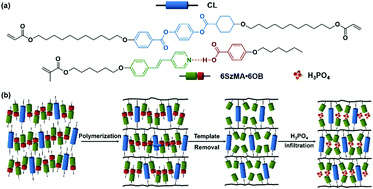当前位置:
X-MOL 学术
›
J. Mater. Chem. C
›
论文详情
Our official English website, www.x-mol.net, welcomes your feedback! (Note: you will need to create a separate account there.)
Proton conductive cationic nanoporous polymers based on smectic liquid crystal hydrogen-bonded heterodimers†
Journal of Materials Chemistry C ( IF 6.4 ) Pub Date : 2018-04-19 00:00:00 , DOI: 10.1039/c8tc00857d Dirk-Jan Mulder 1, 2, 3, 4, 5 , Ting Liang 1, 2, 3, 4, 6 , Yifei Xu 2, 3, 4, 7, 8 , Jeroen ter Schiphorst 1, 2, 3, 4 , Luc M. W. Scheres 1, 2, 3, 4, 9 , Bernette M. Oosterlaken 2, 3, 4, 7, 8 , Zandrie Borneman 2, 3, 4, 6, 8 , Kitty Nijmeijer 2, 3, 4, 6, 8 , Albertus P. H. J. Schenning 1, 2, 3, 4, 10
Journal of Materials Chemistry C ( IF 6.4 ) Pub Date : 2018-04-19 00:00:00 , DOI: 10.1039/c8tc00857d Dirk-Jan Mulder 1, 2, 3, 4, 5 , Ting Liang 1, 2, 3, 4, 6 , Yifei Xu 2, 3, 4, 7, 8 , Jeroen ter Schiphorst 1, 2, 3, 4 , Luc M. W. Scheres 1, 2, 3, 4, 9 , Bernette M. Oosterlaken 2, 3, 4, 7, 8 , Zandrie Borneman 2, 3, 4, 6, 8 , Kitty Nijmeijer 2, 3, 4, 6, 8 , Albertus P. H. J. Schenning 1, 2, 3, 4, 10
Affiliation

|
The fabrication of a cationic nanoporous smectic liquid crystal network (LCN) based on hydrogen bonded heterodimers is presented. The method relies on a supramolecular complex made from a pyridyl bearing reactive mesogen hydrogen bonded to a non-reactive benzoic acid template. Upon addition of a cross-linker, a smectic liquid crystalline phase is obtained that can be fixed by photopolymerization. It was found that the lamellar structure was maintained after template removal when 25 wt% or more cross-linker was used, yielding a nanoporous LCN. After H3PO4 immobilization in the pores of the LCN, a cationic 2D nanoporous polymer is obtained showing high and anisotropic anhydrous proton conductivity.
中文翻译:

基于近晶液晶氢键杂二聚体的质子传导性阳离子纳米多孔聚合物†
介绍了一种基于氢键异二聚体的阳离子纳米多孔近晶液晶网络(LCN)的制备。该方法依赖于由带吡啶基的反应性液晶元氢与非反应性苯甲酸模板键合而成的超分子复合物。添加交联剂后,获得可以通过光聚合固定的近晶液晶相。发现当使用25wt%或更多的交联剂时,在除去模板后层状结构得以保持,从而产生纳米孔LCN。在将H 3 PO 4固定在LCN的孔中之后,获得了阳离子2D纳米多孔聚合物,该聚合物显示出高且各向异性的无水质子电导率。
更新日期:2018-04-19
中文翻译:

基于近晶液晶氢键杂二聚体的质子传导性阳离子纳米多孔聚合物†
介绍了一种基于氢键异二聚体的阳离子纳米多孔近晶液晶网络(LCN)的制备。该方法依赖于由带吡啶基的反应性液晶元氢与非反应性苯甲酸模板键合而成的超分子复合物。添加交联剂后,获得可以通过光聚合固定的近晶液晶相。发现当使用25wt%或更多的交联剂时,在除去模板后层状结构得以保持,从而产生纳米孔LCN。在将H 3 PO 4固定在LCN的孔中之后,获得了阳离子2D纳米多孔聚合物,该聚合物显示出高且各向异性的无水质子电导率。



























 京公网安备 11010802027423号
京公网安备 11010802027423号